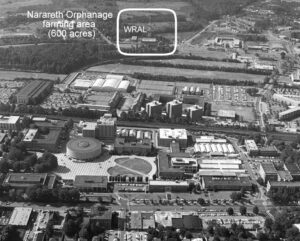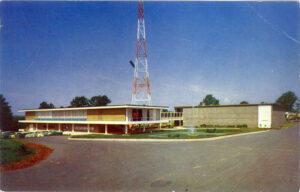
Sometimes “Plan B” turns out to be the best plan.
You may recall an earlier “Throwback Thursday” Capcom story dated December 11, 2014 when we shared Tom Campbell’s story, “David defeats Goliath,” or how CBC defeated Durham Life Insurance Company to win the license to operate a television station in Raleigh. The FCC hearing examiner’s recommendation for CBC to be granted the license was only part of the picture. The FCC Commissioners still had to affirm the hearing examiner’s decision before it became final, and Durham Life still had a little fight left in them.
Plan A for CBC was to operate the station at Cameron Village, located within the city’s limits. One of the allies of Durham Life, a member of the Raleigh City Council who was still smarting over the defeat, passed an ordinance prohibiting transmission towers as tall as the one CBC proposed within the city limits. Mr. A.J. Fletcher, founder of CBC, once again marshalled the troops and got to work. They quickly found a piece of property “in the country” on Western Boulevard. Back in the 50’s, Boylan Heights marked the edge of the city limits.
The location was perfect. The land was beyond the city limits, so a tower could be built with no problems. Team CBC quickly amended the FCC application to reflect the new studio location. A few weeks later, the FCC commissioners met and affirmed the decision of the FCC hearing examiner. Plan B saved the day and thwarted the last gasp attempt to deny CBC.
Retired CBC Vice President Paul Pope is very familiar with this area. His childhood home was located near the station on Nazareth Street. In a recent interview for the CBC History Project, Paul described the land as being very open and rural. At that time, 1956, Nazareth Street was a dirt road.
The Nazareth Catholic Orphanage (built in 1899 and torn down in the late 1970’s) was located on land that is now part of the NC State Centennial Campus. Paul recalls that part of the land, now CBC’s backyard, was farmed and maintained by the orphanage staff. It is hard to imagine that our beautiful campus was once a place where turkeys and cows roamed. A more incredible image to imagine is a hog pen in the lower region of the CBC property, a perfect location where pig slop could drain into a pig stye. Maybe that fertilized ground is partly responsible for one of the most gorgeous azalea gardens in North Carolina!
The marked areas at the top of the picture (below), shows the proximity of WRAL to the Catholic Orphanage/ farm to the NCSU main campus in the late 60’s. (Photo courtesy of Mike Carpenter)
 A photo showing the proximity of WRAL to the Catholic Orphanage/ farm to the NCSU main campus in the late 60’s.
A photo showing the proximity of WRAL to the Catholic Orphanage/ farm to the NCSU main campus in the late 60’s.
 An aerial shot of WRAL-TV studios in 1960.
An aerial shot of WRAL-TV studios in 1960.
The picture on the left is a 1960 aerial view of the WRAL-TV campus showing the surrounding area. Note the Putt-Putt golf course located to the right on land now occupied by Mission Valley Shopping Center. Take a closer look and you will notice that the auditorium had not been added to the studio building yet. (click on photo for larger view)
 A color photo WRAL Buildings circa 1959 (Admin building designed by Milton Small and Joseph Boaz).
A color photo WRAL Buildings circa 1959 (Admin building designed by Milton Small and Joseph Boaz).
The picture on the right look is more familiar to us. Mr. A.J. Fletcher selected G. Milton Small along with Joseph Boaz to design the administration building which was completed in 1959. Small was well known for using modern, clean lines in his design. Small also designed Carter Finley Stadium, the NCSU Student Center, St. Stephen’s Episcopal Church in Durham, and Durham’s Home Security Life Building. (click on photo for larger view)
This aerial picture of the WRAL campus (below) was taken in 1982 by SKY 5 pilot Mike Allen. Here you can see the auditorium building, used by the National Opera Company, that was added to the studio building in 1967. In 1981, the auditorium was converted into the newsroom and news set. Today that area houses Master Control and the mini-studios. Mission Valley Shopping Center is behind the station. The helipad can be seen on top of the administration building.
 Aerial view of the WRAL studios in 1982 (photo by SKY 5 pilot Mike Allen).
Aerial view of the WRAL studios in 1982 (photo by SKY 5 pilot Mike Allen).
The picture below shows two more expansion projects. Construction started in November 1998 on the massive addition that currently holds the newsroom/news set on the second floor. The ground level houses offices for WRAL and FOX 50 creative services, programming and administration. The addition yielded 35,000 feet more space and was completed in 2000.
 A photo from SKY 5 shows the current look of the campus from SKY 5 (photo by WRAL-TV News Photographer Keith Baker).
A photo from SKY 5 shows the current look of the campus from SKY 5 (photo by WRAL-TV News Photographer Keith Baker).
The 300 ft. broadcast relay tower behind the station had to be dismantled and a new tower is now in place about 150 feet northwest of the old location.
The last expansion project provides sales offices, a break-room and an “underground” connector from the broadcast building to the administration building. That project was completed in 2013.
In a future Throwback Thursday article, we will explore the “nine-lives” that some parts of this campus have lived since late 1950’s. Remnants of the past can be found, if you know where to look! Stay tuned.
Thanks to Corp’s Pam Allen for this capcom story. Pam Parris Allen is a former WRAL newscast producer/director who now works as a researcher and producer on the CBC History Project.